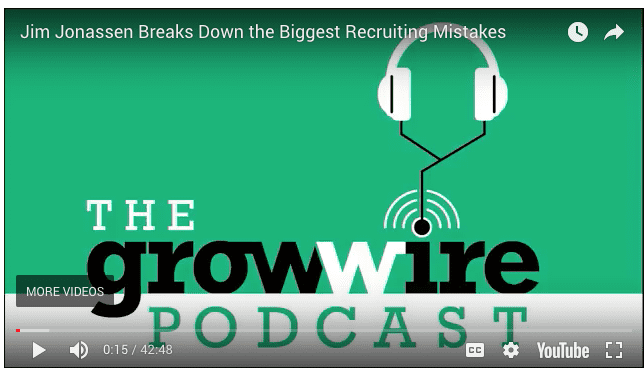
Profitability vs. Killer Talent: Pick Any Two
Why quality hires still make or break every CEO’s profitability imperative.
By Jim Jonassen, JJA Founder
In times like these, the most successful business leaders we know view the future through one primary lens: their org chart. They know from experience that the right talent wins battles for profitability and sustainable growth.
The bottom line is once again THE top priority.
For growth-focused tech investors, the pendulum has clearly swung from greed back to fear. After a decade of near-free debt capital, skyrocketing valuations, large late-stage financing rounds and robust M&A and IPO activity, the P&L is back in vogue.
All those growth-stage company boards who had been encouraging CEOs to stoke the burn in the name of achieving scale – and going public or getting liquid via acquisition – are now demanding a clear path to profitability. And they want to see those healthy numbers now, not later.
No matter how you slice it, today’s version of “the new normal” requires leadership to move beyond easy money and wild growth mandates. It’s time to embrace quaint, seemingly forgotten concepts like cash flow.
Many leadership teams start by slashing the biggest line item in the budget – people. And they’re probably right. But whom you cut and how strongly impacts your ability to attract and motivate great talent in the future. Accomplishing all this with an eye toward profitability is even tougher.
Making reality-based decisions.
Here are three things you can do now to tighten your org chart and improve profitability:
- Perform a clear-eyed assessment of how your leaders and key contributors stack up. There are many assessment tools available. Check out one of the most basic ones here. Then take action. Terminate. Promote. Recruit.
- Focus on concrete objectives that will deliver profitable growth. Examples: ship new features faster; monetize more; shorten the selling cycle; get into new distribution or affiliate channels; decrease customer acquisition costs.
- Decide which core metrics genuinely matter. You won’t find these answers in a book or a blog. They come from seasoned strategic advisors who have built and sustained market-leading companies. Pick up the phone and recruit them to your team, board, advisory or “kitchen cabinet.” If you don’t ask, you won’t get.
Don’t be afraid to shake things up.
If there was ever an ideal moment to look at your current talent roster, this is it. Examine every tier of your organization with a fresh eye. Objectively, do you have the absolute best players on the field? Are they in the right positions?
This question is crucial for leadership roles. And all of your key players need to feel confident they’re surrounded by the same. You know the old saying – game knows game.
If you’re like most leaders, you probably have some B-level talent you’ve been hoping will level up to make the A team. There may even be a few legacy folks you’ve been hanging onto based purely on your shared history. It’s time to give yourself a slap of reality.
Remember, you’re not leading a pro sports team. Many of the challenges may be very similar. But in this line of work, there’s no such thing as a “rebuilding year.”
“And all of your key players need to feel confident they’re surrounded by the same. You know the old saying – game knows game.”
In with the new.
When fine-tuning the top layers of your org chart, there are three main channels to tap. I’ll be going into greater detail on these in future posts, so stay tuned.
- Before wading into the open market, reconsider, assess and re-engage your current employees. Has anyone been overlooked? Or maybe you have someone who’s never been set up for success. That could be due to politics, culture, lack of resources or the wrong functional leadership.
Promote from within, and you’ll have a new manager/leader who can bypass the learning curve and hit the ground running. This also conveys to others that your company is investing in leadership growth.
- The next source is something we call surgical extraction. The idea is to create a heat map of industry sectors, individual companies and even business units where your next trophy hire may be starting to dream of fresh challenges.
Poaching directly from a competitor or a “mentor company” can be tricky. If you’re one or two degrees away from a candidate, you might be able to engineer a warm intro. Another approach is to partner with a trusted headhunter. Bringing in a ringer to do the actual engagement and extraction is the most effective path. (It also lets you maintain plausible deniability if a cease-and-desist letter hits your desk.)
- Another powerful tactic for improving a team is to invest in potential. We counsel our clients to actively seek out those up-and-coming players who appear to be tomorrow’s superstars.
Any calculated risk is, well, risky. But done carefully, it can be far safer than limiting yourself to what we call resume hires – those who have the exact experience you seek but may be past their prime.
Prioritize values, attitude and grit instead; you’ll never be disappointed. This approach has created some of the biggest winners in the innovation economy, and we can tell you from experience that it works.
We’ll say it again – adapt or die.
This is an era when winners are forged, while those who think it safe to sit on their hands will likely end up as roadkill. We strongly believe that the issue of talent acquisition will be a decisive factor either way. Of course, we’re always here to help.
Hey – my name may be on the byline, but the ideas I share are always the product of a team effort. JJA is on a mission to raise the bar in high-stakes recruitment, from retained searches to corporate talent acquisition. We approach life like an open-source project, driven by the belief that there’s always a better way. If you have ideas you’d like to contribute, please email us. To download some of the free tools we’ve developed, visit the JJA website.











